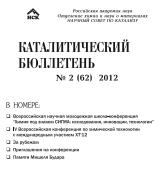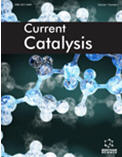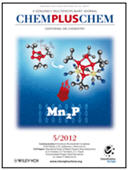
The Knoevenagel condensation can be carried out in water, thanks to a palladium cage catalyst
By Bethany Halford
With the help of a palladium-based cationic cage, researchers in Japan have coaxed a Knoevenagel condensation to take place under neutral conditions in water (J. Am. Chem. Soc., DOI: 10.1021/ja210068f). Knoevenagel condensations are reversible reactions involving attack of a carbanion of a 1,3-dicarbonyl compound on an aldehyde or a ketone followed by dehydration. It’s tough to do the transformation in water because the solvent pushes the equilibrium in favor of hydrated intermediates. And yet, similar condensation reactions are common in biological systems, thanks to the stabilization provided by the specialized environments of enzymes. Seeking to create a synthetic version of this stabilized environment, Makoto Fujita, Takashi Murase, and Yuki Nishijima of the University of Tokyo used a catalytic amount of a palladium cationic cage complex in several aqueous Knoevenagel condensations of aldehydes. They found that the cage-catalyzed reactions produced the desired condensation product in yields as high as 96%. The same reaction conditions without the cage produced only traces of the desired product. The researchers believe the cationic cage, with its hydrophobic core, can sequester organic substrates and stabilize ionic intermediates, much as enzymes do. |
 This palladium cage facilitates Knoevenagel condensations in water. |
Chemical & Engineering News
Public portals to computed data and search tools are set to accelerate the pace of materials discovery
By Mitch Jacoby
Imagine how productive scientists in a given field could be if vast quantities of reliable data were freely and conveniently available to everyone. That idea—simple to state but challenging to implement—was a cornerstone of the Human Genome Project, which assembled massive databases of genetic information. Similar ideas are now generating quite a buzz in the materials discovery community, especially with the recent introduction of two publicly accessible Web-based tools for exploring computed fundamental properties of materials.
Currently, this type of data sharing is limited. But with proponents from academia, national laboratories, and government bodies calling for accelerated development of a public materials information network, open and convenient access to huge stores of scientific data may soon become the norm in materials research. Advocates say that a development of that type could shave as much as a decade off the processes of discovering new materials and optimizing them for use in energy, electronics, national security, and other areas.
“A lot of computational science is being produced today in various labs and institutions. But it’s all very fragmented,” says Kristin Persson, a research chemist and computational specialist at Lawrence Berkeley National Laboratory. “There is a critical need to assemble all that accumulated knowledge and information in a single place so that it can be searched and used productively, instead of just sitting on a private hard drive until it’s forgotten,” she stresses.
Persson and Gerbrand Ceder, a professor of materials science and engineering at Massachusetts Institute of Technology, have taken initial steps to address that need. The two cofounded the Materials Project, a repository of calculated properties of inorganic materials with a publicly accessible Web-based interface for combing through the data.
The website, materialsproject.org, provides users with a number of tools for using the growing databases. For example, it offers users a phase diagram application to search through thermodynamically stable phases of materials and their decomposition pathways. It also gives users access to a reaction calculator for computing enthalpies of thousands of reactions for comparison with experimental results, a lithium-ion-battery explorer for sifting through properties of candidate battery materials, a structure predictor, and other tools.
The database, which was launched in the fall of 2011, currently contains information on more than 19,000 compounds and has attracted roughly 1,000 users. Although the Web utilities and database do not focus exclusively on Li-ion battery applications, they reflect Ceder’s pioneering and ongoing efforts to use computational procedures to search, design, and screen large numbers of known and as-yet-unsynthesized compounds for use as electrodes and other components of Li-ion batteries.
A similar effort, but with a focus on catalyst discovery, is spearheaded by researchers at Stanford University’s Center for Interface Science & Catalysis. The group, which includes postdoctoral associate Jens S. Hummelshøj and chemical engineering professor original: Jens K. Nørskov, a leading figure in computational catalysis research, just launched CatApp, a freely accessible database and Web application for exploring surface chemistry and heterogeneous catalysis. It appears online at http://suncat.slac.stanford.edu/catapp/ and was described in January in Angewandte Chemie International Edition (DOI: 10.1002/anie.201107947).
The CatApp database includes calculated reaction energies and activation energies for more than 1,000 elementary reactions on numerous single-crystal metal surfaces. For example, the data set includes energies for reactions involving C–C, C–H, C–O, O–O, O–H, N–N, C–N, O–N, and N–H bond splitting for molecules with up to three C, N or O atoms on the surfaces of a large collection of transition metals. CatApp includes such data for 18 metallic elements with various crystal structures and geometries, such as stepped and nonstepped face-centered cubic and body-centered cubic. Hummelshøj notes that not only can the program run on personal computers, it can even run on smartphones and tablets.

|
Developers of both database projects say the programs are in their early stages and that expansion plans will soon be put into action. “Our vision is for the Materials Project to become a dynamic Google of material properties,” Persson says. “The plan is for it to continue to grow and change as more users come on board to analyze results, verify against experiments, and increase their knowledge,” she adds. CatApp is also set to grow. “In the coming weeks, researchers will be able to submit their own data upon publication,” Hummelshøj says. For now, the invitation applies only to results obtained computationally, but future plans call for adding experimental results as well. “We also plan to add oxides, carbides, nitrides, sulfides, alloys, and nanoparti-cles,” Hummelshøj says.
Details of catalytic reactions, such as methanol decomposition on copper (shown in this iPhone display), can be accessed via CatApp from mobile devices. |
One point underscored by the development of these databases is that today’s computational methods for materials discovery are powerful. “As a result of tremendous increases in computing power, first-principle methods have reached a stage where they can be used to reliably determine how a material’s structure and the interface it forms with its environment control its properties and reactivity,” says the University of Virginia’s Matthew Neurock, a chemical engineering professor and expert in computational methods. Neurock adds that this information can be used to develop structure-property-reactivity relationships that can be exploited in the discovery of new materials for catalysis, batteries, supercapacitors, photovoltaics, thermoelectrics, and fuel cells. Regardless of application, Nørskov stresses, “the most valuable feature of today’s computational methods is that they allow us to discover trends and variations from one system to the next.”
Many promising novel materials have been discovered computationally. Some recent examples include the discovery by Nørskov’s group of molybdenum sulfides that could serve as low-cost alternatives to platinum electrocatalysts for generating hydrogen from water (Nat. Mater., DOI: 10.1038/nmat3008). Another example is a family of previously unexplored carbonophosphates and carbonosilicates that Ceder’s group is studying computationally and experimentally for use as high-performance cathode materials for Li-ion batteries (J. Mater. Chem., DOI: 10.1039/c1jm12216a).
And in optoelectronics, Alex Zunger of the University of Colorado, Boulder, and coworkers searched through “an astronomical” number of silicon-germanium structural variations and found that SiGe2Si2Ge2Si (subscripts denote the number of monolayers) grown on a silicon-germanium alloy and topped with a germanium layer should be 50 times as efficient at absorbing light as existing Si–Ge superlattices are (Phys. Rev. Lett., DOI: 10.1103/PhysRevLett.108.027401). The team notes that in principle, the unusual material could be prepared via molecular beam epitaxy.
The power of computations in materials research was highlighted this past summer by President Barack Obama when he announced the launch of the Materials Genome Initiative, a $100 million materials research program. The multipronged program is a platform for developing a so-called materials innovation infrastructure to be built upon a foundation of advanced computational techniques, experimental tools, and ready access to digital data.
“Currently, there is no infrastructure that allows scientists and engineers to pursue this integrated vision and share information,” says Cyrus Wadia, an assistant director in the White House Office of Science & Technology Policy. Historically, a gap of 10 to 20 years has occurred from the time a novel material is discovered until it is used in manufacturing of advanced commercial products, Wadia notes. One of the principal goals of the new initiative, Wadia explains, is to drive materials discovery and development at twice the pace and half the cost.
With computational tools and digital data becoming ever more accessible, the role of computers in materials research can only increase, Nørskov says: “We are witnessing the beginning of a new approach to materials discovery.”
Chemical & Engineering News
ChemCatChem
The Catalytic Amination of Alcohols
Sebastian Bähn, Sebastian Imm, Lorenz Neubert, Min Zhang, Helfried Neumann, Matthias Beller
Artificial Metalloenzymes
Fiora Rosati, Dr. Gerard Roelfes
Catalytic Addition of Aromatic C-H Bonds to Vinylsilanes in the Presence of Ru/CeO2
Hiroki Miura, Dr. Kenji Wada, Dr. Saburo Hosokawa, Prof. Dr. Masashi Inoue
Enantiopure Monoprotected cis-1,2-Diaminocyclohexane: One-Step
Preparation and Application in Asymmetric Organocatalysis
Prof. Dr. A. Berkessel, M.-C. Ong, M. Nachi, Dr. J.-M. Neudörfl
Aqueous-Phase Hydrogenation of Acetic Acid over Transition Metal Catalysts
Hakan Olcay, Dr. Lijun Xu, Dr. Ye Xu, Prof. George W. Huber
ChemSusChem
Simple and Efficient Iridium(III)-Catalyzed Water Oxidations
Nicolas Marquet, Felix Gärtner, Sebastian Losse, Marga-Martina Pohl,
Henrik Junge, Matthias Beller
Catalytic Oxy-Functionalization of Methane and Other Hydrocarbons:
Fundamental Advancements and New Strategies
Joanna R. Webb, Tamara Bolaño and T. Brent Gunnoe
Catalytic Oxidative Dehydration of Glycerol over a Catalyst with Iron Oxide Domains Embedded in an Iron Orthovanadate Phase
Feng Wang, Jie Xu, Jean-Luc Dubois and Wataru Ueda
A Tandem Water-Splitting Device Based on a Bio-inspired Manganese
Catalyst
Robin Brimblecombe, Annette Koo, G. Charles Dismukes, Gerhard F. Swiegers and Leone Spiccia
Advanced Synthesis & Catalysis
The Growing Impact of Catalysis in the Pharmaceutical Industry
Carl A. Busacca, Daniel R. Fandrick, Jinhua J. Song, Chris H. Senanayake
Carbenes Made Easy: Formation of Unsymmetrically Substituted
N-Heterocyclic Carbene Complexes of Palladium(II), Platinum(II) and Gold(I) from Coordinated Isonitriles and their Catalytic Activity
A. Stephen K. Hashmi, Christian Lothschütz, Constantin Böhling,
Tobias Hengst, Christoph Hubbert, Frank Rominger
Finding Furfural Hydrogenation Catalysts via Predictive Modelling
Zea Strassberger, Maurice Mooijman, Eelco Ruijter, Albert H. Alberts,
Ana G. Maldonado, Romano V. A. Orru, Gadi Rothenberg
Angewandte Chemie International Edition
Catalytic Redox Reactions in the CO/N2O System Mediated by the Bimetallic Oxide-Cluster Couple AlVO3+/AlVO4+
Zhe-Chen Wang, Nicolas Dietl, Robert Kretschmer, Thomas Weiske,
Maria Schlangen, Helmut Schwarz
An Efficient Titanium Catalyst for Enantioselective Cyanation
of Aldehydes: Cooperative Catalysis
Zhipeng Zhang, Zheng Wang, Ruzhou Zhang and Kuiling Ding
Preparation and Regioselective Diels–Alder Reactions of Borylbenzynes: Synthesis of Functionalized Arylboronates
Takashi Ikawa, Akira Takagi, Yurio Kurita, Kozumo Saito, Kenji Azechi, Masahiro Egi, Keisuke Kakiguchi, Yasuyuki Kita and >nobr>Shuji Aka
Palladium-Catalyzed β Arylation of Carboxylic Esters
Alice Renaudat, Ludivine Jean-Gérard, Rodolphe Jazzar,
Christos E. Kefalidis, Eric Clot and Olivier Baudoin
Chemistry – A European Journal
A Convenient and General Palladium-Catalyzed Carbonylative Coupling for the Synthesis of 2-Arylbenzoxazinones
Xiao-Feng Wu, Johannes Schranck, Helfried Neumann, Matthias Beller
Unifying Metal and Bronsted Acid Catalysis—Concepts, Mechanisms, and Classifications
Magnus Rueping, Rene M. Koenigs, Iuliana Atodiresei
Selective Iron-Catalyzed Oxidation of Phenols and Arenes with Hydrogen Peroxide: Synthesis of Vitamin E Intermediates and Vitamin K3
Konstanze Möller, Gerrit Wienhöfer, Kristin Schröder, Benoit Join,
Kathrin Junge, Matthias Beller
Modulation of the Aerobic Oxidative Polymerization in Phenylazomethine
Dendrimers Assembling Copper Complexes
Takane Imaoka, Yuki Kawana, Masahiro Tsuji, Kimihisa Yamamoto
Chemistry – An Asian Journal
Nickel-Catalyzed Allylic Substitution of Simple Alkenes
Ryosuke Matsubara, Timothy F. Jamison
Catalytic Enantioselective Arylation of Glyoxylate with Arylsilanes:
Practical Synthesis of Optically Active Mandelic Acid Derivatives
Kohsuke Aikawa, Yūta Hioki, Koichi Mikami
A Heterobimetallic Ni/La-salan Complex for Catalytic Asymmetric
Decarboxylative 1,4-Addition of Malonic Acid Half-Thioester
Makoto Furutachi, Shinsuke Mouri, Shigeki Matsunaga, Masakatsu Shibasaki
Helvetica Chimica Acta
Stepwise Mechanism of Hydroxide Ion Catalyzed Cyclization
of Uridine 3’-Thiophosphates
Mikko Ora, Anne Hansk
Enzyme-Catalyzed Stereoselective Synthesis of Two Novel Carbasugar Derivatives
Ayşegül Gümüş, Cihangir Tanyeli
Chinese Journal of Chemistry
Robust CoAl Alloy: Highly Active, Reusable and Green Catalyst in the
Hydrogenolysis of Glycerol
Xiaoyang Guo, Anyuan Yin, Xiaodong Guo, Xiuying Guo, Weilin Dai, Kangnian Fan
Theoretical Investigation on the Mechanism and Design of Catalysts
for Nitrolysis of Hexamine
Liangwei Shi, Gang Zhao, Yazhu Zhang, Changwu Zheng, Guangming Qin, Jian Lü
Journal of the Chinese Chemical Society
An Easy and Efficient Synthesis of Bisindolylmethanes and
Tetraindolylmethane Tröger’s Base Catatlyzed by AgBF4
Ajam C. Shaikh, Chinpiao Chen
Israel Journal of Chemistry
Applicable Properties of Cucurbiturils
Galit Parvari, Ofer Reany, Ehud Keinan
Highly (≥ 98%) Selective Trisubstituted Alkene Synthesis of Wide Applicability via Fluoride-Promoted Pd-Catalyzed Cross-Coupling of Alkenylboranes
Ei-ichi Negishi, Tomas Tobrman, Honghua Rao, Shiqing Xu, Ching-Tien Lee
Cobalt-Catalyzed Cross-Coupling Reactions of Aryl Halides
Corinne Gosmini, Aurélien Moncomble
Macromolecular Rapid Communications
Nickel(II) α-Diimine Catalyst for Grignard Metathesis (GRIM)
Polymerization
Harsha D. Magurudeniya, Prakash Sista, Jacob K. Westbrook,
Taryn E. Ourso, Khuong Nguyen, Marie C. Maher, Mussie G. Alemseghed, Michael C. Biewer, Mihaela C. Stefan
Discrete Metal Catalysts for Stereoselective Ring-Opening Polymerization
of Chiral Racemic β-Lactones
Jean-François Carpentier
Macromolecular Reaction Engineering
Comprehensive Investigation of Catalyst Structure and Polymerization Conditions for Chain Branching in Ethylene Polymerization with
Phillips-Type Catalysts
Xiaoyang Guo, Anyuan Yin, Xiaodong Guo, Xiuying Guo, Weilin Dai, Kangnian Fan
Reducing ATRP Catalyst Concentration in Batch, Semibatch and
Continuous Reactors
Nicky Chan, Michael F. Cunningham, Robin A. Hutchinson
Macromolecular Chemistry and Physics
Efficiency Increase of Poly(ethylene terephthalate-co-isosorbide terephthalate)
Synthesis using Bimetallic Catalytic Systems
Jean Christophe Bersot, Nicolas Jacquel, René Saint-Loup, Patrick Fuertes, Alain Rousseau, Jean Pierre Pascault, Roger Spitz, Françoise Fenouillot, Vincent Monteil
Synthesis of Narrowly Distributed ω-Telechelic Hyperbranched
Polyethylenes by Efficient End-Capping of Pd-Diimine-Catalyzed Ethylene "Living" Polymerization with Styrene Derivatives
Shiyun Li, Zhibin Ye
Ni-Catalyzed Polymerization of Poly(3-alkoxythiophene)s
Karlien Van den Bergh, Julien De Winter, Pascal Gerbaux, Thierry Verbiest, Guy Koeckelberghs
Zeitschrift für anorganische und allgemeine Chemie
Preparation and Structural Characterization of RuII-DMSO and
RuIII-DMSO-substituted α-Keggin-type Phosphotungstates, [PW11O39RuIIDMSO]5– and [PW11O39RuIIIDMSO]4–, and Catalytic Activity for Water Oxidation
Masahiro Sadakane, Niklas Rinn, Sachie Moroi, Hiroaki Kitatomi,
Tomoji Ozeki, Mariko Kurasawa, Masaya Itakura, Shinjiro Hayakawa,
Kazuo Kato, Mayumi Miyamoto, Shuhei Ogo, Yusuke Ide, Tsuneji Sano
Progress in the Compilation of an Oxovanada-Silsesquioxane Portfolio and Catalytic Activity of Organometallic Representatives in Ethylene
Polymerisation
Christian Ohde, Christian Limberg, Dennis Schmidt, Markus Enders,
Serhiy Demeshko, Christina Knispel
Macromolecular Theory and Simulations
Determination of the Catalytic Sites for Ziegler-Natta Homo-Polymerization from GPC Data
Sridhar V. Maddipati, W. Nicholas Delgass, James M. Caruthers
Chemical Engineering & Technology
Glycerol-Reforming Kinetics Using a Pt/C Catalyst
Parag N. Sutar, Prakash D. Vaidya, Alirio E. Rodrigues
Post-Plasma Catalysis for Methane Partial Oxidation to Methanol: Role of the Copper-Promoted Iron Oxide Catalyst
Lin Chen, Xingwang Zhang, Liang Huang, Lecheng Lei
Chemie Ingenieur Technik
Dehydratisierung von Glycerin zu Acrolein in der Gasphase an geträgerten
Heteropolysäure-Katalysatoren
Udo Armbruster, Hanan Atia, Andreas Martin
Veredelung nachwachsender Rohstoffe durch Selektivoxidation mit
Goldkatalysatoren
Ulf Prüße, Katharina Heidkamp, Nadine Decker, Mirko Herrmann,
Klaus-Dieter Vorlop
European Journal of Organic Chemistry
Evolution and Synthetic Applications of the Heck–Matsuda Reaction: The Return of Arenediazonium Salts to Prominence
Jason G. Taylor, Angélica Venturini Moro, Carlos Roque D. Correia
Efficient Copper-Catalyzed Direct Amination of Aryl Halides Using Aqueous Ammonia in Water
Fei Meng, Xinhai Zhu, Ying Li, Jianwei Xie, Bo Wang, Junhua Yao, Yiqian Wan
Transition-Metal-Catalyzed Direct C–H Alkenylation, Alkynylation,
Benzylation, and Alkylation of (Hetero)arenes
Samir Messaoudi, Jean-Daniel Brion and Mouâd Alami
European Journal of Inorganic Chemistry
Titanium Complexes Stabilized by Bulky Electron-Rich Aminopyridinates and Their Application in Ethylene and Styrene Polymerization
Muhammad Hafeez, Winfried P. Kretschmer, Rhett Kempe
Donor-Functionalised Expanded Ring N-Heterocyclic Carbenes: Highly
Effective Ligands in Ir-Catalysed Transfer Hydrogenation
Abeer Binobaid, Manuel Iglesias, Dirk Beetstra, Athanasia Dervisi, Ian Fallis and Kingsley J. Cavell
The Chemical Record
Transition-metal-catalyzed aminations and aziridinations of C-H and C=C bonds with iminoiodinanes
Joyce Wei Wei Chang, Thi My Uyen Ton, Philip Wai Hong Chan
Asia-Pacific Journal of Chemical Engineering
Software tools overview: process integration, modelling and optimisation for energy saving and pollution reduction
Hon Loong Lam, Jiří Jaromír Klemeš, Zdravko Kravanja,
Petar Sabev Varbanov
Chemistry & Biodiversity
Synthesis, Characterization, and DNA-Binding and -Cleavage Properties of Dinuclear CuII Salophen/Salen Complexes
Pulimamidi Rabindra Reddy, Addla Shilpa
Process Safety Progress
Imperial sugar refinery combustible dust explosion investigation
John B. Vorderbrueggen
Environmental Toxicology
Investigation of acute nanoparticulate aluminum toxicity in zebrafish
Robert J. Griffitt, April Feswick, Roxana Weil, Kelly Hyndman,
Paul Carpinone, Kevin Powers, Nancy D. Denslow, David S. Barber
Method for the Production of Deuterium-Depleted Potable Water
Feng Huang and Changgong Meng
http://c.acs.org/czihv/457707/0/480431/12949/0/D/0/0/rhzd.html
Banana Peel Applied to the Solid Phase Extraction of Copper and Lead from River Water: Preconcentration of Metal Ions with a Fruit Waste
Renata S. D. Castro, La rcio Caetano, Guilherme Ferreira, Pedro M. Padilha, Margarida J. Saeki, Luiz F. Zara, Marco Antonio U. Martines, and
Gustavo R. Castro
http://c.acs.org/czihv/457707/0/480431/12950/0/D/0/0/rhzd.html
Methods for Pretreatment of Lignocellulosic Biomass for Efficient Hydrolysis and Biofuel Production
Parveen Kumar, Diane M. Barrett, Michael J. Delwiche and Pieter Stroeve
http://c.acs.org/czihv/457707/0/480431/12951/0/D/0/0/rhzd.html
Membrane Gas Separation: A Review/State of the Art
P. Bernardo, E. Drioli and G. Golemme
http://c.acs.org/czihv/457707/0/480431/12952/0/D/0/0/rhzd.html
Chemical Reaction Engineering
Octave Levenspiel
http://c.acs.org/czihv/457707/0/480431/12953/0/D/0/0/rhzd.html
Synthesis of Biodiesel via Acid Catalysis
Edgar Lotero, Yijun Liu, Dora E. Lopez, Kaewta Suwannakarn, David A. Bruce, and James G. Goodwin, Jr.
http://c.acs.org/czihv/457707/0/480431/12954/0/D/0/0/rhzd.html
One-Pot Synthesis of Ethanolamine-Modified Mesoporous Silica
Pezhman Zarabadi-Poor, Alireza Badiei, Bradley D. Fahlman, Pezhman Arab, and Ghodsi Mohammadi Ziarani
http://c.acss.org/czihv/457707/0/480431/12955/0/D/0/0/rhzd.html
Biomedical Applications of Metal Organic Frameworks
Seda Keskin and Seda Kizilel
http://c.acs.org/czihv/457707/0/480431/12956/0/D/0/0/rhzd.html
Solar Energy Storage Methods
Yu Hou, Ruxandra Vidu, and Pieter Stroeve
http://c.acs.org/czihv/457707/0/480431/12957/0/D/0/0/rhzd.html
Less-Common Nanostructures in the Forms of Vegetation
Oxana V. Kharissova and Boris I. Kharisov
http://c.acs.org/czihv/457707/0/480431/12958/0/D/0/0/rhzd.html
Current Catalysis Новый журнал Current Catalysis Current Catalysis is an international peer-reviewed journal, which publishes original research, expert reviews and thematic issues in all core areas of catalysis including theoretical, experimental and applied research. The scope includes heterogeneous catalysis, homogeneous catalysis, bio-catalysis, synthesis and properties of new catalysts including synthesis and catalytic function of novel inorganic solids and complexes, studies that relate catalytic function to fundamental chemical processes in metal complexes and at surfaces, novel concepts in surface chemistry.
ChemistryOpen Журнал открытого доступа ChemistryOpen выходит с февраля 2012 г. Его выпуск организован Wiley-VCH и ChemPubSoc Europe, ассоциацией 16 Европейских химических обществ. The First Society-Owned Open Access Chemistry Journal ChemistryOpen publishes peer-reviewed primary research in all areas of chemistry, and thus satisfies funding organizations and institutes which require that the research funded by them should be accessible to all.
Wiley-VCH and ChemPubSoc Europe, an association of 16 chemical societies, have announced the launch of ChemistryOpen, the first open access chemical society journal. The societies are joining a new open access publishing program announced by John Wiley & Sons. ChemistryOpen will publish peer-reviewed primary research in all areas of chemistry, and will thus satisfy funding organizations and institutes which require that the research funded by them should be accessible to all. As an additional feature, the new journal will publish short summaries of PhD theses with a link to the full version. This Thesis Treasury will make PhD theses in Chemistry readily accessible while linking them through CrossRef to all cited journal articles in the program. ChemPlusChem http://www.chempluschem.org Междисциплинарный журнал
ChemPlusChem выходит с января 2012 г. Выпускается ChemPubSoc Europe
и Wiley-VCH. Публикуемые статьи должны охватывать две или более области химии либо сочетать химию с другой областью знания. ChemPlusChem пришел на смену прекратившему свое существование в конце 2011 г. журналу Collection of Czechoslovak Chemical Communications. ChemPlusChem, a multidisciplinary journal centering on chemistry, is set to become a high-quality forum for multidisciplinary original papers. Original papers published will cover at least two different aspects (subfields) of chemistry or one of chemistry and one of another scientific discipline (one chemistry topic plus another one, hence the title ChemPlusChem). ChemPlusChem, in this new exciting form, will succeed the Collection of Czechoslovak Chemical Communications which ceased publication at the end of 2011. ChemPlusChem will, as its predecessor did, feature strictly peer-reviewed full papers, communications, reviews, and mini-reviews from all subfields of chemistry. The journal will be published online only, ensuring rapid publication and colourful presentation of the results. The first issue has appeared in January 2012. ChemPlusChem is tailored to multidisciplinary chemistry, biology, ma-terials, and physics researchers from across the world. Collaboration is a prerequisite to multidisciplinary science, and the portion of papers with contributions from two or more research groups has more than doubled within the last ten years in Chemistry journals. ChemPlusChem is the first journal to specifically provide a high-quality forum for papers arising from these scientific partnerships. Journal of Petroleum and Gas
Exploration Research
(JPGER) http://interesjournals.org/JPGER Междисциплинарный журнал открытого доступа, посвященный исследованию, производству и переработке нефти, природного газа, нефтепродуктов и биотоплива. Выпускается International Research Journals. JPGER is a multidisciplinary peer reviewed, open access journal that is concerned with exploration, production, processing and refining, storage and transportation, economical, managerial, business, environmental, safety and security issues related to oil, natural gas, and petrochemicals as well as manufacturing and refining of biofuels. The journal covers disciplines and fields related to oil and gas prospecting, production, processing and utilization as well as that of other energy sources. The journal publishes original articles, review articles, in English, giving an overview of the contributions of complementary disciplines in tackling contemporary problems. Journal of Petroleum and Gas Exploration Research publishes articles in all subject areas in our open access journals. JPGER is published monthly (one volume per year) by International Research Journals. The Journal welcomes the submission of manuscripts that meet the general criteria of significance and scientific excellence. Papers will be published approximately one month after acceptance. All articles pub-lished in JPGER are peer-reviewed.Новые журналы в области химии
Editor-in-Chief: Shaobin Wang
Curtin University, Australia
издается Bentham Science, охватывает все области катализа. 
Editors: Karen Hindson, Haymo Ross
Deputy Editor: Natalia Ortuzar

Editor: Neville Compton
Deputy Editor: Marisa Spiniello
Journal of Petroleum and
Gas Exploration Research
выходит с 2011 г. 